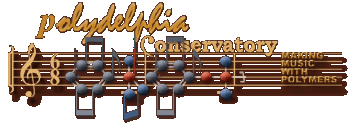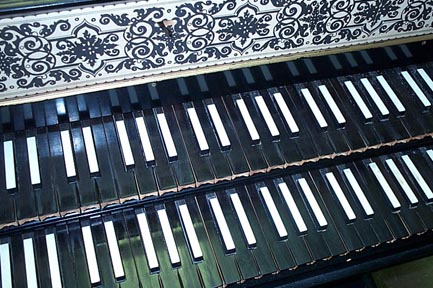Keyboard instruments come in such a variety that the fact that they all are activated by keys is a pretty superficial thing by which to group them together. The harpsichord is really a type of stringed instrument, while the pipe organ is more like a huge woodwind. The piano is a type of percussion instrument with the felt hammers striking the strings. But he one thing they almost certainly have in common besides keys is polymers. In fact, the piano has so many polymers that is gets its own page.
The harpsichord is what most people played before the piano got popular. There are actually several historic keyboards which worked the same way as a harpsichord - using keys to pluck a set of strings. Bach even wrote music for the lute harpsichord, which is - of course - a harpsichord that sounds much like a lute.
Most of the harpsichord is made of wood including the case and the soundboard. Even the keys of most of these instruments are wooden. Another traditional material for keys is ivory, which has now been replaced by plastic like celluloid.
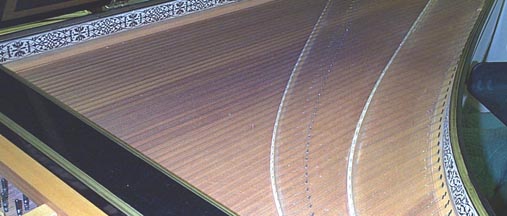
The soundboard is often made of spruce, cypruss or cedar.
|
A harpsichord is a bit simpler than a piano in how it works. Each key moves a "jack" which contains a plectrum - the quil that moves past the string to pluck it - and a wool felt damper, which stops the string almsot immediately when the jack falls back into its place as the key is released.
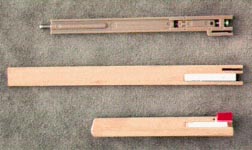
various types of jacks -
plastic and wood
|
The jack itself may be Delrin plastic or wood. Believe it or not, woods, such as pear, beech and walnut, are still the most desirable and stable materials for jacks because over time plastic tends to warp, shrink, and degrade in ways that wood doesn't. The plastic jacks are also heavier, presenting problems in properly balancing the action of the instrument.
The plectra are often made of Delrin high performance plastic, but they have also been made from materials such as styrene, nylon and vinyl, with little success.
In the old days plectra were made out of natural materials like leather, and were much more difficult to maintain, replace, and voice.
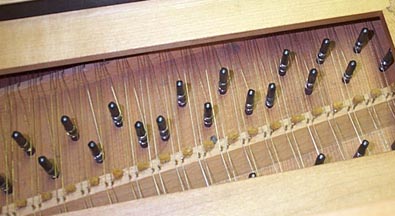
the pinblock and tuning pins
|
The best pletctrum material is considered to be bird quills, formaed from natural polymers called keratins, but these are harder to keep and don't last as long as Delrin plectra.
Each jack has a tongue, made of wood or plastic which holds the plectrum and is hinged so that the string is not plucked again when the jack slides back into place.
The keys - much like a piano - are also padded with felt underneath and on the ends and the pivots to prevent them making any moise while operating. The strings are made of steel wire like piano strings, though they are much thinner and have much less tension. Though there is less tension, the strings are held taught the same as in a piano, by tuning pins drilled into a wooden pinblock. These pins are much smaller and easier to turn than the ones on a piano, but the pinblock still endures a lot of pressure, so it must be made form a dense, stable wood like oak or walnut.

 On the left you can see the organ swell encased in wood
and on the right some of
On the left you can see the organ swell encased in wood
and on the right some of
the wooden
flute pipes can be seen among the ranks.
|
The pipe organ is arguably the biggest and most complicated musical instrument there is. Each note is sounded by one or more metal pipes. The flute pipes have a lip that sounds the note like a recorder or whistle, while reed pipes have a brass reed in the bottom, sort of like a big bagpipe drone. So an organ could be considered a woodwind instrument since it uses a vibrating column of air to produce sound. And though most of the pipes are metal, some of them can be made of wood.
Another use of wood on a pipe organ is on the group of pipes called the swell. Over these pipes are wooden slats that can be opened and closed like window shades to cause the swell to get louder and softer.
The main polymers in a pipe organ are in the console where the keys and pedals are played. The keys - like piano keys - used to be made of ivory and wood, but now they are made of polystyrene or other plastics. The console itself is wood, as are the big foot pedals which are used to play the gigantic low pipes.

The low organ pedals look like a keyboard.
|
These pedals are made just like a huge keyboard, with the small black pedals corrosponding to the black keys on the keyboard. So an organist has to be very coordinated to play all those keys and pedals at the same time, not to mention working the stops. The buttons and handles that control the stops - which change the shound of the organ - are made of some kind of plastic as well. And many of the cotraptions inside the organ that control the stops are made of wood.
If Tchaikovsky had never gone to America in 1891 for the opening of Carnegie Hall and seen an unusual new keyboard instrument, which had actually been invented in France, who knows if we would still play the celesta today. When Tchaikovsky wrote his Nutcracker Suite in 1892, he featured this instrument in "The Dance of the Sugar Plum Faeries," and now its warm, magical bell sound is synonymous with the Christmas holidays.
The bell sound is made by hammers hitting metal bars when the keys are pressed. The hammers are operated with the same type of action used in a piano - which is made from wood and felt - and the metal bars are much like those on a glockenspiel, but each bar has a wood resonator that amplifies and carries the tone. The celesta also has a wooden outer case and keys like a piano, made from wood and polystyrene.
Synthesizer keyboards come in a lot of shapes and sizes, all the way from basic models for the beginner to complicted systems that look and sound like a regular piano.
The outer cases of these are often polystyrene, except for those that are made to look like pianos, which might have real wood cases.
The keys are all polystyrene, though the nicer synthesizers have heavy wooden keys with plastic tops like a real piano. This makes them feel like a regular piano as well as looking like one.
This digital piano even has regular piano pedals that look and feel like those of a traditional piano.
And of course these instruments are full of electronics with circuit boards made from epoxy resins and wires insulated with materials such as vinyl (PVC).

Sources for this page | Instrument Index | HOME | TOP
